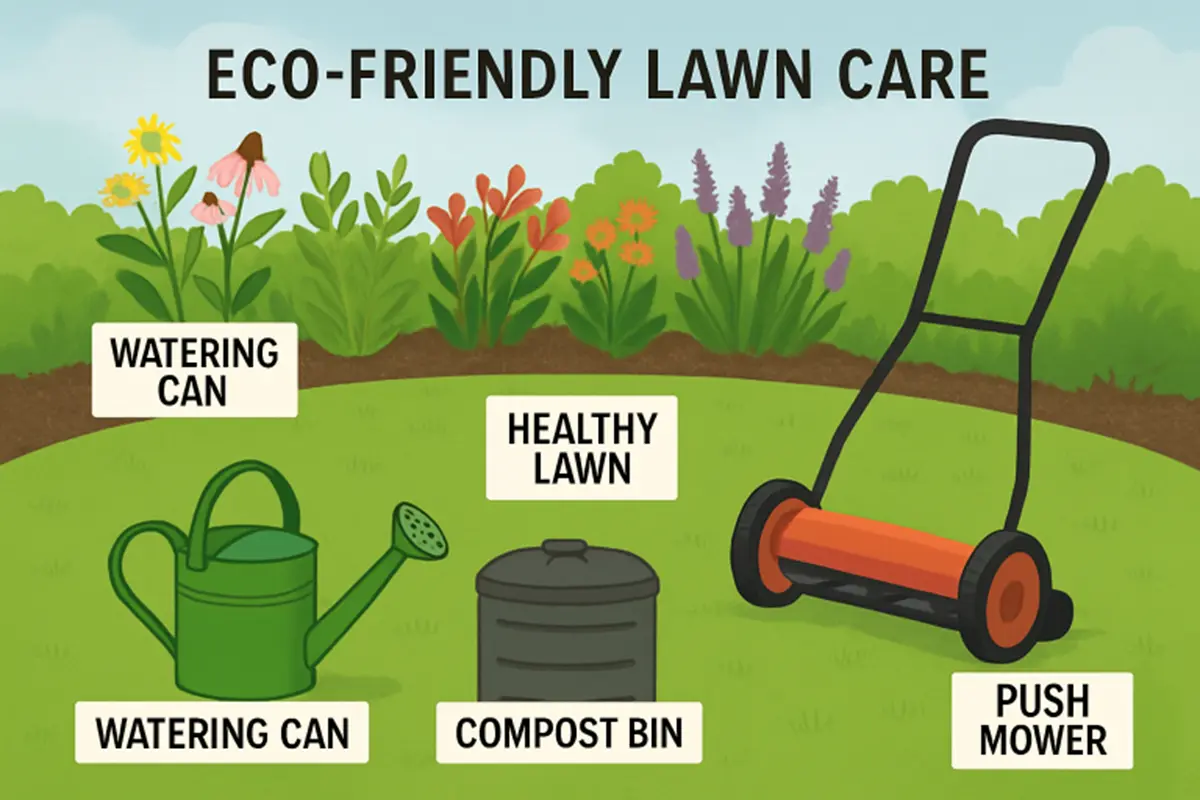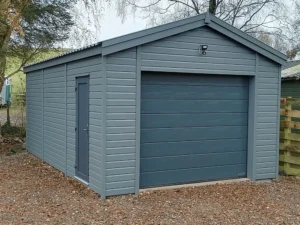Key Takeaways
- Utilize organic fertilizers to nourish your lawn naturally and safely.
- Incorporate native plants to promote biodiversity and reduce maintenance needs.
- Implement efficient watering techniques to conserve water and save money.
- Practice proper mowing habits to enhance lawn health and resilience.
- Embrace natural pest control methods to protect beneficial insects and pollinators.
As homeowners become increasingly eco-conscious, finding ways to nurture your yard while protecting the environment is more important than ever. Many are beginning to recognize that traditional lawn care methods—often reliant on chemical fertilizers, excessive watering, and gas-powered equipment—can have long-term negative effects on the ecosystem. By making simple changes to your lawn care routine, you can create a vibrant outdoor space with a lighter environmental footprint. These changes not only benefit your yard but also contribute to cleaner air, purer water, and the well-being of local wildlife. For those seeking specialized care and expertise, consider reaching out to professional lawn care in Charlotte for tailored advice and service designed specifically for your regional climate and soil conditions. Choosing eco-friendly lawn care is not just a trend—it’s an essential step toward living more sustainably.
Eco-friendly lawn practices not only benefit the planet but also lead to healthier soil, thicker grass, and more resilient plants. Lawn care rooted in environmentally friendly methods supports local biodiversity, encourages beneficial insects, and conserves valuable natural resources such as water. This type of stewardship also helps prevent harmful runoff from entering nearby streams, lakes, and rivers, which is crucial for protecting aquatic ecosystems. Whether you’re a seasoned gardener with years of experience or just starting, adopting sustainable techniques can make a visible difference in your yard. The following tips will guide you toward a thriving, sustainable landscape that you and your neighbors can enjoy for many years to come—all while knowing you are making a positive impact on your community and the greater environment.
Use Organic Fertilizers
Traditional chemical fertilizers often contain synthetic ingredients that can degrade soil quality over time and seep into local water systems, contributing to pollution in streams, lakes, and rivers. These chemicals—while offering fast results—may disrupt the natural balance of soil microbes and harm beneficial organisms like earthworms. Organic alternatives, such as compost, well-aged manure, or natural plant-based products, enrich your lawn by fostering healthier soil biology and releasing nutrients slowly over time. Organic fertilizers support the long-term health of your yard, helping it become more drought-tolerant and resistant to pests. Before choosing a product, conduct a soil test to identify which nutrients your lawn needs and avoid over-fertilization. This not only saves you money but also prevents the buildup of excess nutrients, which can harm plants and nearby waterways.
Incorporate Native Plants
Native species are well-adapted to your local climate, rainfall patterns, and soil, which makes them less dependent on supplemental water, fertilizer, or pesticides. These plants tend to require less maintenance since they’re naturally resistant to many common local pests and diseases. They foster local biodiversity, attract a wide variety of pollinators—such as butterflies, hummingbirds, and native bees—and offer habitat and food sources for wildlife. Incorporating even a few native plant beds will help stabilize soil and reduce erosion, especially in areas susceptible to runoff. Start by researching which native varieties naturally thrive in your region, and gradually replace thirsty turfgrass or exotic ornamental plants with these hardy, climate-appropriate options for a balanced, low-maintenance yard. Native plants also enhance your yard’s appearance with seasonal changes, varied textures, and colorful blooms, giving your landscape a unique, regionally distinctive look.
Implement Efficient Watering Techniques
Overwatering wastes precious resources and can promote shallow root growth, leaving your lawn less resilient to both drought and disease. The key to efficient watering is to irrigate deeply—but less frequently—so that moisture reaches the root zone, training grass roots to grow deeper and become hardier. The best time to water is early in the morning, when evaporation is low and winds are calm, which allows plants to absorb moisture more effectively. Consider installing drip irrigation systems or soaker hoses for targeted watering that minimizes waste. Even using a simple sprinkler timer can help you avoid overdoing it. Catching rainwater in barrels further reduces your reliance on municipal water supplies, lowering your utility bills and helping mitigate local water shortages. Adapt your watering schedule to the season, weather, and rainfall—most lawns only need about one inch of water per week, including rainfall, to stay healthy and green.
Practice Proper Mowing Habits
Mowing may seem like the simplest lawn care task, but how and when you mow makes a significant difference in overall lawn health. Set your mower blade to 3–4 inches to keep grass dense and robust, which helps shade out weeds, discourages pests, and reduces water evaporation from the soil. Taller grass also develops deeper roots, making your lawn more drought-resistant. Regularly sharpen your mower blade to ensure clean cuts that heal quickly, reducing the stress on your grass and minimizing the potential for disease entry. Whenever possible, leave short grass clippings on the lawn so they can decompose quickly and return nutrients to the soil instead of bagging them. This practice, known as grasscycling, further reduces waste while naturally fertilizing your yard. Avoid mowing when the ground is wet to reduce the risk of spreading disease and to prevent soil compaction, which can stifle healthy root development.
Embrace Natural Pest Control Methods
Controlling pests without the use of chemicals helps maintain a balanced ecosystem, allowing beneficial insects to thrive. Synthetic pesticides may eliminate more than just pests, often harming pollinators and other garden allies in the process. Encourage natural predators—such as ladybugs, lacewings, and birds—by planting a diversity of flowering species and providing shelter such as brush piles or birdhouses. Physical barriers, like row covers or netting, can effectively deter certain pests. For infestations that require intervention, opt for organic solutions such as neem oil, insecticidal soap, or diatomaceous earth, which target pests while minimizing harm to beneficial species. Healthy, well-aerated soil, diverse plantings, and proper lawn maintenance deter most pest outbreaks before they start. Need advice identifying which insects help and which hurt your plants? The National Geographic provides an excellent primer on recognizing pollinators and beneficial bugs.
Enhance Soil Health
Healthy soil underpins every aspect of lawn and garden growth. It acts as a reservoir for water and nutrients, providing a supportive environment for strong, healthy grassroots. Regular aeration—done by removing small soil plugs—breaks up compacted earth, allowing water, nutrients, and oxygen to reach the roots more effectively. This is especially important in high-traffic areas or places with heavy clay soil. After aerating, apply a thin layer of compost to introduce organic matter and beneficial microbes, enriching the soil and improving its structure. Over time, you’ll notice increased earthworm activity, richer soil color, improved water retention, and a lawn that requires fewer inputs to remain lush and green. Monitoring soil health regularly and making necessary amendments ensures your yard remains vibrant from season to season.
Start Composting
Composting is a cornerstone of sustainable gardening. By recycling everyday yard and kitchen waste—such as grass clippings, leaves, coffee grounds, and vegetable peels—you reduce landfill burden while creating a nutrient-rich amendment for your lawn and garden beds. Balance “green” materials, like fresh grass and food scraps, with “brown” ingredients, such as dry leaves, shredded newspaper, and cardboard, to maintain a healthy compost pile that breaks down efficiently. Turning the pile regularly introduces oxygen and speeds decomposition, resulting in finished compost ready for use in the spring and fall. Spread compost on your lawn to restore soil health, enhance nutrient cycling, and build disease resistance naturally.
Choose Eco-Friendly Lawn Equipment
Gas-powered mowers and trimmers contribute significantly to air and sound pollution, and their emissions can negatively impact local and global air quality. Modern alternatives—such as manual reel mowers or battery-powered electric models—offer a quieter, cleaner solution with lower emissions and less maintenance. Choosing equipment powered by renewable energy, if available at your home, further reduces your carbon footprint. While electric tools may require an initial investment, they often last longer, are easier to operate, and reduce your yard’s overall environmental impact. Hand tools, like rakes and hand-push spreaders, can further minimize your use of fossil fuels and are perfect for small lawns and detail work.
By adopting these eco-friendly lawn care practices, you’ll support a healthier yard and planet. Small, mindful changes add up over time, resulting in a landscape that’s beautiful, resilient, and sustainable for years to come. You’ll take pride in knowing you are caring for both your property and the greater environment, setting a positive example for your community and inspiring others to make greener choices as well.
Conclusion
Eco-friendly lawn care is about more than maintaining curb appeal—it’s about creating a thriving outdoor space that benefits both your family and the environment. By using sustainable practices like natural fertilizers, proper watering, and native plant choices, you can nurture a healthier yard while conserving resources and reducing harmful impacts. With these green strategies, your lawn can flourish as a beautiful, resilient, and environmentally responsible part of your home.










